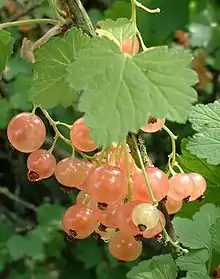White currant
The white currant or whitecurrant is a group of cultivars of the red currant (Ribes rubrum), a species of flowering plant in the family Grossulariaceae, native to Europe.
| White currant | |
|---|---|
 | |
| Hybrid parentage | Ribes rubrum (red currant) |
| Origin | Central and Eastern Europe |
| Nutritional value per 100 g (3.5 oz) | |
|---|---|
| Energy | 234 kJ (56 kcal) |
13.8 g | |
| Sugars | 7.37 g |
| Dietary fiber | 4.3 g |
0.2 g | |
1.4 g | |
| Vitamins | Quantity %DV† |
| Thiamine (B1) | 3% 0.04 mg |
| Riboflavin (B2) | 4% 0.05 mg |
| Niacin (B3) | 1% 0.1 mg |
| Pantothenic acid (B5) | 1% 0.064 mg |
| Vitamin B6 | 5% 0.07 mg |
| Folate (B9) | 2% 8 μg |
| Choline | 2% 7.6 mg |
| Vitamin C | 49% 41 mg |
| Vitamin E | 1% 0.1 mg |
| Vitamin K | 10% 11 μg |
| Minerals | Quantity %DV† |
| Calcium | 3% 33 mg |
| Iron | 8% 1 mg |
| Magnesium | 4% 13 mg |
| Manganese | 9% 0.186 mg |
| Phosphorus | 6% 44 mg |
| Potassium | 6% 275 mg |
| Sodium | 0% 1 mg |
| Zinc | 2% 0.23 mg |
| Other constituents | Quantity |
| Water | 84 g |
| |
| †Percentages are roughly approximated using US recommendations for adults. Source: USDA FoodData Central | |
It is sometimes mislabelled as Ribes glandulosum,[1][2][3] which is the 'skunk currant' in the USA.
Description
It is a deciduous shrub growing to 1 m (3 ft) tall and broad, with palmate leaves, and masses of spherical, edible fruit (berries) in summer. The white currant differs from the red currant only in the colour and flavour of these fruits, which are a translucent white and sweeter.[4]
Cultivation
Unlike their close relative the blackcurrant, red and white currants are cultivated for their ornamental value as well as their berries.[5]
Currant bushes grow best in partial to full sunlight and can be planted between November and March in well-drained, slightly neutral to acid soil.[4] They are considered cool-climate plants and fruit better in northern areas. They can also be grown in large containers.[4]
The firm and juicy fruit are usually harvested in summer. Whole trusses of fruits should be cut instead of individual fruit,[6] and then either used, or they can be stored in a fridge. They can also be bagged and frozen.[4]
Various forms are known including 'Blanka',[3] 'White Pearl',[7] and 'Versailles Blanche' (syn ‘White Versailles’).[4][6][8] 'Versailles Blanche' was first bred in France in 1843.[9]
The cultivars 'White Grape' and 'Blanka' have gained the Royal Horticultural Society's Award of Garden Merit.[10][11] There are also cultivars with yellow and pink fruit, called respectively 'yellow currants' and 'pink currants'.[6]
The bushes can suffer from pests such as gooseberry sawfly and birds.[4] The bushes are best grown in fruit cages for protection.[9]
Culinary uses
White currant berries are slightly smaller and sweeter than red currants. When made into jams and jellies the result is normally pink. The white currant is actually a less pigmented cultivar of the red currant but is marketed as a different fruit. White currants are rarely specified in savoury cooking recipes compared with their red counterparts. They are often served raw and provide a sweetly tart flavor.[8] White currant preserves, jellies, wines[12] and syrups are also produced.[6] In particular, white currants are the classic ingredient in the highly regarded Bar-le-duc or Lorraine jelly although preparations made of red currants can also be found.[13]
Nutrition
White currant berries are 84% water, 14% carbohydrates, 1% protein, and contain negligible fat (table). In a 100 gram (3.5 oz) reference amount, white currant berries supply 56 calories, and are a rich source (49% of the Daily Value, DV) of vitamin C and a moderate source (10% DV) of vitamin K, with no other micronutrients in appreciable amounts (table).
See also
References
- "White currant (Ribes glandulosum) (With images) | Fruit plants". Pinterest. Retrieved 6 June 2020.
- Michael Thurlow Grow Your Own Fruit and Veg (2010), p. 126, at Google Books
- Darina Allen Grow, Cook, Nourish (2018), p. 898, at Google Books
- "Whitecurrants". rhs.org.uk. Retrieved 28 January 2017.
- Klein, Carol (2009). Grow your own fruit. United Kingdom: Mitchell Beazley. p. 224. ISBN 9781845334345.
- "White Currant Berries". specialtyproduce.com. Retrieved 28 January 2017.
- "Ribes rubrum 'White Pearl'". victoriananursery.co.uk. Retrieved 29 January 2017.
- Hamilton, Geoff (1990). The Ornamental Kitchen Garden. London: BBC Books. p. 229. ISBN 0563360178.
- Kirsten Hartvig Healing Berries: 50 Wonderful Berries, and How to Use Them in Health-giving Immunity-boosting food and drinks (2016), p. 69, at Google Books
- "RHS Plant Selector - Ribes rubrum 'White Grape'". Retrieved 30 May 2013.
- https://www.rhs.org.uk/plants/details?plantid=1629
- A Practical Chemist The Cyclopædia of Practical Receipts in All the Useful and Domestic Arts (1841), p. 27, at Google Books
- "Bar-Le-Duc Jelly". cooksinfo.com. Retrieved 29 January 2017.
External links
- Currants, California Rare Fruit Growers, 1996